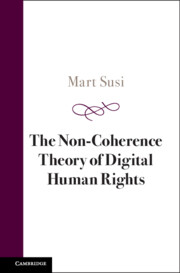Book contents
- The Non-coherence Theory of Digital Human Rights
- The Non-coherence Theory of Digital Human Rights
- Copyright page
- Contents
- Acknowledgements
- Introduction
- Part I The Contextual Challenges and Purpose of the Non-coherence Theory of Digital Human Rights
- 1 Horizontal and Vertical Governance Models and Normativity
- 2 The Ontological Dimension
- 3 The Epistemic Dimension
- 4 On the Controversy about the Relative Weight of Rights
- 5 Constitutional Entitlements to Human Rights in the Digital Domain
- Part II Reflections on Some Theories and Doctrines
- Part III The Core Elements of Non-coherence Theory
- Part IV The Impact of the Non-coherence Theory
- Part V Internet Balancing Formula
- In Lieu of the Concluding Remarks
- Index
1 - Horizontal and Vertical Governance Models and Normativity
from Part I - The Contextual Challenges and Purpose of the Non-coherence Theory of Digital Human Rights
Published online by Cambridge University Press: 22 February 2024
- The Non-coherence Theory of Digital Human Rights
- The Non-coherence Theory of Digital Human Rights
- Copyright page
- Contents
- Acknowledgements
- Introduction
- Part I The Contextual Challenges and Purpose of the Non-coherence Theory of Digital Human Rights
- 1 Horizontal and Vertical Governance Models and Normativity
- 2 The Ontological Dimension
- 3 The Epistemic Dimension
- 4 On the Controversy about the Relative Weight of Rights
- 5 Constitutional Entitlements to Human Rights in the Digital Domain
- Part II Reflections on Some Theories and Doctrines
- Part III The Core Elements of Non-coherence Theory
- Part IV The Impact of the Non-coherence Theory
- Part V Internet Balancing Formula
- In Lieu of the Concluding Remarks
- Index
Summary
The idea of non-coherence theory originates from the distorted image of well-established human rights in digital settings. This distorted image appears in various ontological and epistemic aspects. It reveals an absence of clarity on whether human rights rules and principles, the possibility of their realisation and related obligations and remedies against violations as established in the offline world (human rights law and practice as we know it) continue to exist online with or without variance. If variance exists, what is the degree and consequences of such variance, whether it amounts to distortion, and if distorted, whether its degree calls into question the feasibility or limits the scope of the transposability of offline human rights law and practice to online. The ambition of the non-coherence theory of digital human rights therefore lies, among many other characteristics, in providing a conceptual framework for understanding the implications from the co-existence of multiple internet governance models.
Keywords
- Type
- Chapter
- Information
- The Non-Coherence Theory of Digital Human Rights , pp. 7 - 19Publisher: Cambridge University PressPrint publication year: 2024

